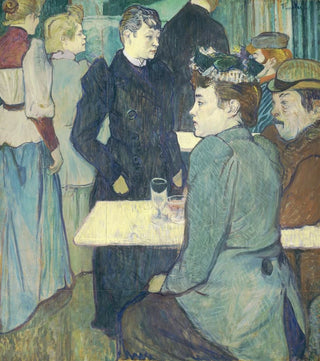Art print | A corner of the Moulin de la Galette - Henri de Toulouse-Lautrec


View from behind

Frame (optional)
Art print Un coin du Moulin de la Galette - Henri de Toulouse-Lautrec – Engaging introduction
In late 19th-century Paris, a iconic place stands out for its festive atmosphere and vibrant nightlife: the Moulin de la Galette. It is within this lively setting that Henri de Toulouse-Lautrec, a versatile artist, captured the very essence of that era through his emblematic work, "Un coin du Moulin de la Galette." This painting, which evokes conviviality and joie de vivre, transports the viewer to the heart of a scene where dancers, drinkers, and dreamers mingle, all gathered under the soft lights of a popular dance hall. The art print Un coin du Moulin de la Galette - Henri de Toulouse-Lautrec allows you to rediscover this unique atmosphere while paying tribute to an artist whose genius has left a lasting mark on art history.
Style and uniqueness of the work
The work "Un coin du Moulin de la Galette" is distinguished by its inimitable style, characterized by vivid colors and bold painting techniques. Toulouse-Lautrec employs quick, expressive brushstrokes, creating a dynamic movement that seems to animate the characters. The composition of the piece is carefully orchestrated, with figures arranged to guide the viewer’s eye across the scene. The interplay of light and shadow, as well as contrasts between warm and cool tones, enhances the sense of depth and vitality. Each character, whether a graceful dancer or a man engaged in conversation, is rendered with particular attention to detail, revealing expressions and postures that tell a story. This ability to capture the present moment and immortalize scenes of conviviality makes this work a true masterpiece of the post-impressionist movement.
The artist and his influence
Henri de Toulouse-Lautrec, born in 1864, is often regarded as one of the pioneers of modern art. His work is marked by a deep understanding of Parisian life, especially among the working classes and artists. His physical disability, which forced him into a shorter stature than average, influenced his worldview and his way of representing the

Matte finish

View from behind

Frame (optional)
Art print Un coin du Moulin de la Galette - Henri de Toulouse-Lautrec – Engaging introduction
In late 19th-century Paris, a iconic place stands out for its festive atmosphere and vibrant nightlife: the Moulin de la Galette. It is within this lively setting that Henri de Toulouse-Lautrec, a versatile artist, captured the very essence of that era through his emblematic work, "Un coin du Moulin de la Galette." This painting, which evokes conviviality and joie de vivre, transports the viewer to the heart of a scene where dancers, drinkers, and dreamers mingle, all gathered under the soft lights of a popular dance hall. The art print Un coin du Moulin de la Galette - Henri de Toulouse-Lautrec allows you to rediscover this unique atmosphere while paying tribute to an artist whose genius has left a lasting mark on art history.
Style and uniqueness of the work
The work "Un coin du Moulin de la Galette" is distinguished by its inimitable style, characterized by vivid colors and bold painting techniques. Toulouse-Lautrec employs quick, expressive brushstrokes, creating a dynamic movement that seems to animate the characters. The composition of the piece is carefully orchestrated, with figures arranged to guide the viewer’s eye across the scene. The interplay of light and shadow, as well as contrasts between warm and cool tones, enhances the sense of depth and vitality. Each character, whether a graceful dancer or a man engaged in conversation, is rendered with particular attention to detail, revealing expressions and postures that tell a story. This ability to capture the present moment and immortalize scenes of conviviality makes this work a true masterpiece of the post-impressionist movement.
The artist and his influence
Henri de Toulouse-Lautrec, born in 1864, is often regarded as one of the pioneers of modern art. His work is marked by a deep understanding of Parisian life, especially among the working classes and artists. His physical disability, which forced him into a shorter stature than average, influenced his worldview and his way of representing the






